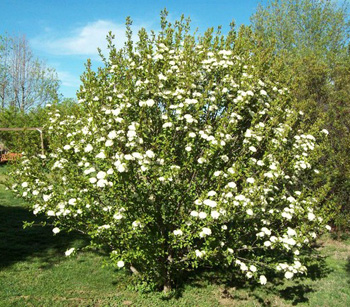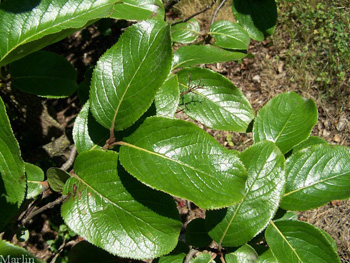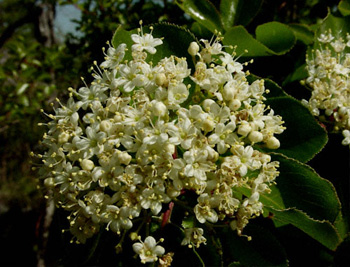Contents:
Common Names | Parts Usually Used | Plant(s) & Culture | Where Found | Medicinal Properties | Biochemical Information
Legends, Myths and Stories | Uses | Formulas or Dosages | Warning | Bibliography
Scientific Names

- Viburnum prunifolium L.
- Caprifoliaceae
- Honeysuckle family
Common Names
- American sloe
- Cramp bark (V. opulus)
- Sheepberry
- Stagbush
Parts Usually Used
Stem bark and root bark
Back to Top
Description of Plant(s) and Culture

A shrub or small tree
Back to Top
Where Found
Found in bogs, low woods; Eastern United States, but found in most North American states. More abundant in Connecticut to Florida; Texas to eastern Kansas.
Back to Top

Medicinal Properties
Antispasomodic, analgesic, astringent, sedative, cardiac tonic, uterine and muscle relaxant, nervine, diuretic, tonic
Back to Top
Biochemical Information
Amentoflavone, coumarins, scopoletine and aesculetine, arbutin, oleanolic, and ursolic acids, sterol.
Back to Top
Legends, Myths and Stories
Black Haw was a favorite with the Eclectics of 19th century America.
Back to Top
Uses
It treats all nervous complaints, including convulsions, hysteria, stress and spasms. It is one of the most reliable remedies for menstrual cramps, uterine tonic, spasms, high blood pressure, chills, fever, and pains. It is often combined with false unicorn root (Helonias) as a preferred treatment against miscarriage. It also is used to treat asthma, palpitations, heart disease and hysterical fits. It is good for painful affections, including arthritis and rheumatic complaints. It is a heart tonic, improves blood circulation.
An extract of the boiled bark aids in childbirth and as a preventative of miscarriage in early pregnancy. It acts like a sedative on uterine muscles, stops menstrual cramps and afterbirth pains. Research has confirmed uterine-sedative properties.
Cramp bark (Viburnum opulis), usually is used alternately with black haw. Cramp bark is weaker, containing about a third of the resins of black haw.
Black haw is sometimes called cramp bark (erroneously).
Back to Top
Formulas or Dosages
Dig up the root in the fall and strip off the bark.
Standard infusion or
Back to Top
Warning
Berries may produce nausea and other uncomfortable symptoms.
Back to Top
Bibliography
![]() Planetary Herbology
Planetary Herbology, by Michael Tierra, C.A., N.D., O.M.D., Lotus Press, PO Box 325, Twin Lakes. WI 53181., Copyright 1988, published 1992
![]() American Folk Medicine
American Folk Medicine, by Clarence Meyer, Meyerbooks, publisher, PO Box 427, Glenwood, Illinois 60425, 1973
![]() The Complete Medicinal Herbal
The Complete Medicinal Herbal, by Penelope Ody, Dorling Kindersley, Inc, 232 Madison Avenue, New York, NY 10016, First American Edition, copyright 1993
![]() Indian Herbalogy of North America
Indian Herbalogy of North America, by Alma R. Hutchens, Shambala Publications, Inc., Horticultural Hall, 300 Massachusetts Avenue, Boston, Massachusetts 02115, 1973
 Old Ways Rediscovered
Old Ways Rediscovered, by Clarence Meyer, Meyerbooks, publisher, PO Box 427, Glenwood, Illinois 60425, published from 1954, print 1988
![]() Eastern/Central Medicinal Plants
Eastern/Central Medicinal Plants, by Steven Foster and James A. Duke., Houghton Mifflin Company, 215 Park Avenue South, New York, NY 10000
![]() Webster’s New World Dictionary
Webster’s New World Dictionary, Third College Edition, Victoria Neufeldt, Editor in Chief, New World Dictionaries: A Division of Simon & Schuster, Inc., 15 Columbus Circle, New York, NY 10023
 The Rodale Herb Book: How to Use, Grow, and Buy Nature’s Miracle Plants (An Organic gardening and farming book)
The Rodale Herb Book: How to Use, Grow, and Buy Nature’s Miracle Plants (An Organic gardening and farming book), edited by William H. Hylton, Rodale Press, Inc. Emmaus, PA, 18049., 1974
